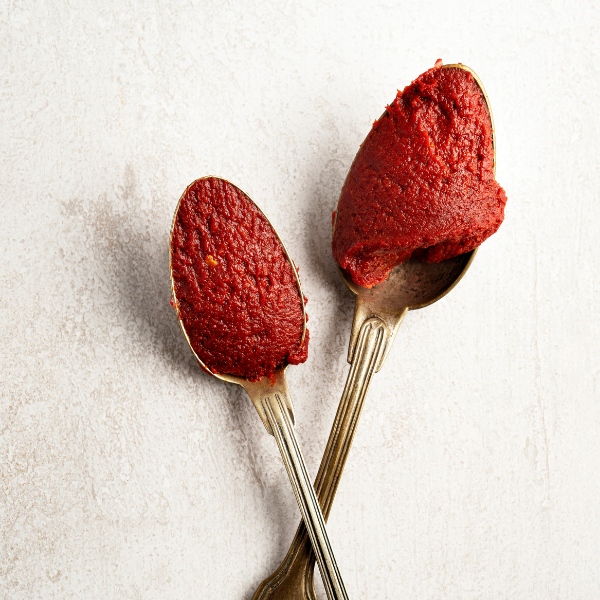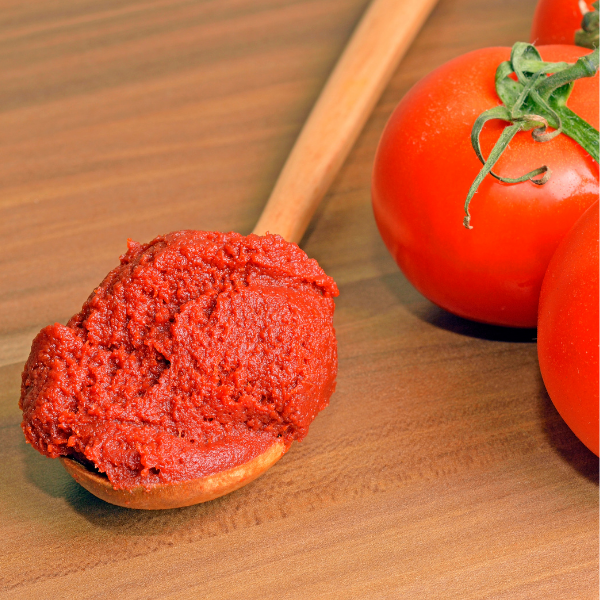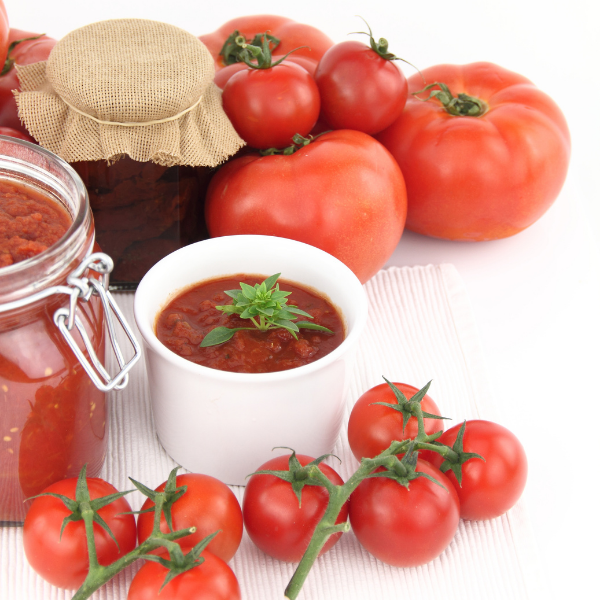
Historical Origin of Tomato Paste
- Origin and spread: Tomato is a plant brought to Europe from the American continent in the 16th century. It spread rapidly especially in Mediterranean cuisine and tomato paste was developed in this region. It was first used extensively in Mediterranean countries such as Italy and Spain, and then entered the world cuisines.
- Industrial Production: Tomato paste started to be produced industrially with the industrial revolution. At the end of the 19th century, with the development of canning techniques, tomato paste production reached wider masses.

Types of Tomato Paste
Tomato paste is produced and used in different ways in different cultures around the world:
- Italian Passata: A less dense, strained tomato puree. It is often used in more watery dishes.
- Turkish Paste: In traditional Turkish cuisine, tomato paste is thick and usually salty. Turkish tomato paste is also made by drying it in the sun, which enhances its intense flavour.
- Spanish Sofrito: It is a type of tomato-based sauce made by roasting ingredients such as tomatoes, peppers and garlic in Spanish cuisine. It creates the basic flavours of the dishes.


Production Stages
- First Stage Selecting the Tomato: The best quality tomatoes are fully ripe, intensely coloured tomatoes with a low water content. Such tomatoes are ideal for making a more flavourful tomato paste.
- Boiling and Thickening: The tomatoes are first boiled and drained. Then they are cooked over low heat to allow the water to evaporate. At this stage, most of the water evaporates and the natural flavours of the tomatoes intensify.
- Sun Drying (Traditional Method): Some traditional tomato paste producers dry the tomatoes in direct sunlight to obtain a thicker consistency. This method allows the water in the tomatoes to evaporate naturally and intensifies the flavour of the tomato paste.

Different Usage Areas
- Use as a Preservative: In traditional societies, tomato paste was used as a natural preservative in some meat dishes. The acidic nature of the paste slows down the deterioration of the meat and makes the dish last longer.
- Usage in World Cuisines: Tomato paste is used not only in Turkish cuisine, but also in different dishes around the world. It is used as a base for pizza sauce in Italian cuisine, enchilada sauce in Mexican cuisine and curry bases in Indian cuisine.
- Marinating: Using tomato paste in marinating meat and vegetables not only increases the flavour but also makes the food more tender and aromatic. It is especially preferred in barbecue and oven dishes.


Health Benefits
- Cancer Protective Effect: Studies show that lycopene in tomato paste increases during the cooking process. Especially cooked tomato products (tomato paste, sauce, etc.) are more easily absorbed by the body, which increases their anti-carcinogenic effects.
- Daily Lycopene Intake: 1-2 tablespoons of tomato paste per day can meet the amount of lycopene needed by the body. Therefore, tomato paste is a powerful source of antioxidants that you can easily include in your daily diet.
- Cholesterol and Heart Health: Lycopene in tomato paste may help lower LDL (bad) cholesterol and help keep arteries clear, which supports heart health.
- Intensive Lycopene Source: Tomato paste contains lycopene in a concentrated form. Lycopene is better absorbed by the body when cooked and bound to fat. Therefore, tomato paste is a great source for lycopene intake.
- Rich Vitamin and Mineral Depot: Tomato paste is a concentrated form of vitamins and minerals found in tomatoes. It contains vitamins C, A and K, potassium, folic acid and iron.
- Regulates Blood Sugar: Thanks to its low glycaemic index, it can prevent sudden rise in blood sugar.
- Regulates Cholesterol: Lycopene and other antioxidants may lower bad cholesterol (LDL) and protect against cardiovascular disease.
- A Material Adding Flavour and Colour: Tomato paste gives both flavour and a natural colour to dishes. It also increases the nutritional value of the dishes.

Correct Storage Conditions
- Mould Prevention: Tomato paste can quickly become mouldy when it comes into contact with air after opening. To prevent this, it is useful to add olive oil to the paste or store it in vacuum containers.
- Freezer Storage: Storing the tomato paste in portions in the freezer keeps it fresh for a long time. You can freeze the tomato paste using small containers or ice cube trays and use it as needed.


Healthy Consumption Recommendation
- Consuming tomatoes and tomato paste with healthy fats such as olive oil increases the absorption of lycopene.
- The use of tomato paste in daily meals may be beneficial in the long term in reducing the risks of cancer and heart disease.
Tomatoes and tomato paste are not only delicious but also important for a healthy life. Therefore, it is useful to use it regularly in meals!
